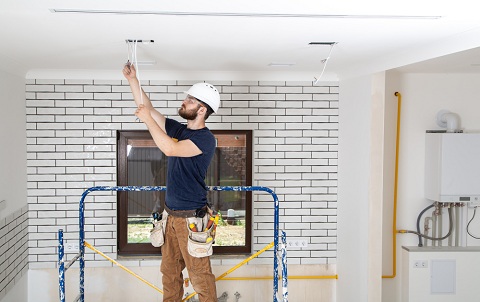False ceilings, also known as drop ceilings or suspended ceilings, have become a popular interior design choice for homeowners and businesses alike. These ceilings, installed below the original ceiling, offer a myriad of benefits but also come with their share of drawbacks. In this comprehensive guide, we’ll delve into the pros and cons of false ceilings, exploring various aspects to help you make an informed decision for your space.
Pros of False Ceilings
Enhanced Aesthetics
One of the primary reasons people opt for false ceilings is the aesthetic appeal they bring to a space. These ceilings allow for creative designs, concealing imperfections and providing a polished, modern look.
Temperature Regulation
False ceilings act as insulators, helping regulate room temperature. They trap air between the original ceiling and the false ceiling, contributing to energy efficiency by keeping the room warmer in winter and cooler in summer.
Acoustic Benefits
For spaces that require sound insulation, false ceilings are a practical solution. They absorb sound, reducing echoes and creating a more acoustically pleasing environment, making them ideal for home theaters or offices.
Concealed Wiring and Fixtures
False ceilings offer a practical way to hide unsightly wires, pipes, and fixtures. This not only enhances the visual appeal but also makes maintenance and repairs more accessible.
Cons of False Ceilings
Cost Considerations
While false ceilings offer numerous benefits, they can be expensive to install. Homeowners must consider the initial investment and weigh it against the long-term advantages.
Reduced Ceiling Height
In rooms with low ceilings, installing a false ceiling can further reduce the height, making the space feel cramped. Careful consideration is needed to ensure the room remains comfortable.
Installation Challenges
Installing a false ceiling can be a complex task that requires professional expertise. DIY attempts may lead to uneven surfaces and a less-than-perfect finish.
Maintenance Issues
False ceilings, especially those in areas prone to moisture, can develop issues over time. Maintenance, including cleaning and addressing water damage, is crucial to ensuring their longevity.
Types of False Ceilings
As you explore the world of false ceilings, it’s essential to understand the various types available to suit different preferences and requirements.
Gypsum Ceilings
Gypsum false ceilings are popular for their versatility and aesthetic appeal. They are easy to install and can be molded into intricate designs, offering a sophisticated look. Gypsum also has fire-resistant properties, adding an extra layer of safety to your space.
Metal Ceilings
Metal false ceilings are known for their durability and contemporary appearance. They are resistant to moisture, making them suitable for areas prone to humidity. Additionally, metal ceilings are low-maintenance and can be a stylish choice for modern interiors.
Wooden Ceilings
For a warm and natural feel, wooden false ceilings are an excellent option. They add a touch of elegance to any space and can complement various interior styles. However, it’s crucial to consider maintenance, as wood may be susceptible to moisture and pests.
PVC Ceilings The Pros and Cons of False Ceilings
PVC false ceilings are popular for their affordability and resistance to moisture. They come in a variety of colors and designs, providing a cost-effective way to enhance the visual appeal of your space. PVC ceilings are also easy to clean, making them suitable for kitchens and bathrooms.
FAQs About The Pros and Cons of False Ceilings
The cost varies based on materials and complexity. On average, it can range from $5 to $15 per square foot.
Yes, it’s possible, but structural considerations and the condition of the existing ceiling should be evaluated first.
PVC and metal ceilings are suitable for humid climates due to their resistance to moisture.
Some materials, like gypsum, are fire-resistant, enhancing the overall safety of your space.
Yes, but it requires proper support and installation to ensure safety and functionality.
Conclusion
The decision to install a false ceiling involves weighing the pros and cons against the specific needs of your space. While they offer enhanced aesthetics, temperature regulation, and acoustic benefits, the cost and potential maintenance issues should not be overlooked. Before making a final decision, consider consulting with professionals and exploring the diverse range of materials and designs available.





